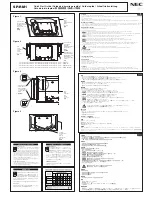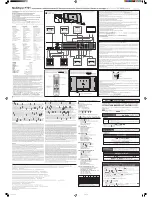
Function
Settings
Description
Color Mode
BT.2020
BT.709
DCI-P3
PQ_BT.2100
PQ_DCI-P3
HLG_BT.2100
CAL1
CAL2
CAL3
SYNC_SIGNAL
Switch to the desired mode according to the monitor application.
Note
•
For more information on how to switch modes, see
the Display Mode (color mode)” (page 11)
.
•
Regarding "CAL1 / CAL2 / CAL3" see
.
Brightness
48 cd/m
2
to
1000 cd/m
2
The screen brightness is adjusted by changing the brightness of the
backlight (light source from the LCD back panel).
Note
•
If a value that cannot be set is selected, the value will appear in
magenta. In such a case, change the value.
•
48 cd/m
2
to 300 cd/m
2
can be set in increments of 1, and 300 cd/
m
2
to 1000 cd/m
2
can be set in increments of 100.
Temperature
Native
4000 K to
10000 K
D50
D65
D65 (CRT)
DCI
User
The color temperature can be adjusted.
The color temperature is used to express the chromaticity of "White".
The value is expressed in degrees "K" (Kelvin).
The screen becomes reddish at a low color temperature, and bluish
at a high color temperature, like the temperature of a flame.
Specify a color temperature in units of 100 K, or select a standard
name.
Note
•
Select "Native" to display the original colors of the LCD panel.
•
"Gain" allows you to perform more advanced adjustment. When
gain is changed, the color temperature is changed to "User".
•
The gain preset values are set for each color temperature setting
value
.
Gamma (EOTF)
1.6 to 2.7
sRGB
EBU(2.35)
PQ
HLG
Adjust the gamma.
The brightness of the monitor varies depending on the input signal,
however, the variation rate is not simply proportional to the input
signal. The control performed to keep the balance between the
input signal and the brightness of the monitor is called "Gamma
correction".
Set the gamma, or select a standard name.
Note
•
If you select "HLG", you must set "HLG System Gamma".
20
Chapter 3 Advanced Adjustments/Settings















































